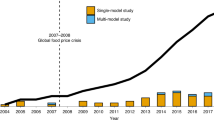Abstract
Background/objectives
To report on the reliability and validity of a Diet Quality Index (DQI) to assess preschoolers dietary patterns using a short food frequency questionnaire (sFFQ) and 3-day food records (3d-FR).
Subjects/methods
Seventy-seven preschool carers/parents completed a telephone interview on preschoolers (2–5-year olds) dietary habits in metropolitan Sydney. Agreement in scores was assessed using intraclass correlation (ICC) and paired t-tests for repeated sFFQ–DQI scores and Bland–Altman methods and paired t-tests for sFFQ–DQI and 3d-FR–DQI scores.
Results
Mean-total sFFQ–DQI ICC scores was high = 0.89, 95% CI (0.81, 0.93). There was weak agreement between sFFQ–DQI and 3d-FR–DQI scores (r = 0.36, p < 0.01). The 3d-FR–DQI scores were positively associated with carbohydrate, folate, ß-carotene, magnesium, calcium, protein, total fat and negatively associated with sugar, starch, niacin, vitamin C, phosphorus, polyunsaturated fat, and monounsaturated fat.
Conclusions
The sFFQ–DQI demonstrated good reliability but weak validity. Associations between nutrients and 3d-FR–DQI scores indicate promising usability and warrants further investigation. Further research is needed to establish its validity in accurately scoring children’s diet quality using sFFQ compared to 3d-FR before the tool can be implemented for use in population settings.
This is a preview of subscription content, access via your institution
Access options
Subscribe to this journal
Receive 12 print issues and online access
$259.00 per year
only $21.58 per issue
Buy this article
- Purchase on Springer Link
- Instant access to full article PDF
Prices may be subject to local taxes which are calculated during checkout
Similar content being viewed by others
References
Lazarou C, Newby P. Use of dietary indexes among children in developed countries. Adv Nutr. 2011;2:295–303.
Perry CP, Keane E, Layte R, Fitzgerald AP, Perry IJ, Harrington JM. The use of a dietary quality score as a predictor of childhood overweight and obesity. BMC Public Health. 2015;15(1):581.
Kant AK. Indexes of overall diet quality: a review. J Am Diet Assoc. 1996;96(8):785–91.
Kennedy ET, Ohls J, Carlson S, Fleming K. The Healthy eating index. J Am Diet Assoc. 1995;95(10):1103–8.
Patterson RE, Haines PS, Popkin BM. Diet quality index: capturing a multidimensional behavior. J Am Diet Assoc. 1994;94(1):57–64.
Flood VM, Wen LM, Hardy LL, Rissel C, Simpson JM, Baur LA. Reliability and validity of a short FFQ for assessing the dietary habits of 2–5-year-old children, Sydney, Australia. Public Health Nutr. 2014;17(03):498–509.
NHMRC. Eat for Health: Australian Dietary Guidelines Summary. Canberra: NHMRC, Department of Health and Ageing; 2013. Contract No.: ISBN: 1864965789.
Rangan AM, Randall D, Hector DJ, Gill TP, Webb KL. Consumption of /‘extra/‘ foods by Australian children: types, quantities and contribution to energy and nutrient intakes. Eur J Clin Nutr. 2007;62(3):356–64.
Australian Bureau of Statistics (ABS). Australian Health Survey: Nutrition First Results—Food & Nutrients 2011–12. Canberra: ABS; 2014. Report No. 43640DO008.
Huybrechts I, Vereecken C, De Bacquer D, Vandevijvere S, Van Oyen H, Maes L, et al. Reproducibility and validity of a diet quality index for children assessed using a FFQ. Br J Nutr. 2010;104(1):135–44.
Acknowledgements
This research is related to the work of the Healthy Beginnings Trial (HBT); however the participants of this study were not part of the HBT. The study was funded by the Australian National Health and Medical Research Council (ID number: 393112).
Author contributions
The authors’ contributions are as follows: KK and VF developed the DQI tool, KK carried out the data analyses, interpretation of findings and wrote the manuscript. LMW and LB contributed to the data interpretations. VF was the principal investigator and contributed to the study design, data collection and interpretation of findings. MH contributed to the data analyses and study interpretations All authors read and approved the final version of the manuscript.
Compliance with ethical standards
Informed consent was obtained from all parents for being included in the study.
Author information
Authors and Affiliations
Corresponding author
Ethics declarations
Competing interests
All authors listed have contributed sufficiently to the project to be included as authors, and all those who are qualified to be authors are listed in the author byline. The authors declare that they have no competing financial interests.
Rights and permissions
About this article
Cite this article
Kunaratnam, K., Halaki, M., Wen, L.M. et al. Reliability and comparative validity of a Diet Quality Index for assessing dietary patterns of preschool-aged children in Sydney, Australia. Eur J Clin Nutr 72, 464–468 (2018). https://doi.org/10.1038/s41430-017-0020-y
Received:
Revised:
Accepted:
Published:
Issue Date:
DOI: https://doi.org/10.1038/s41430-017-0020-y



